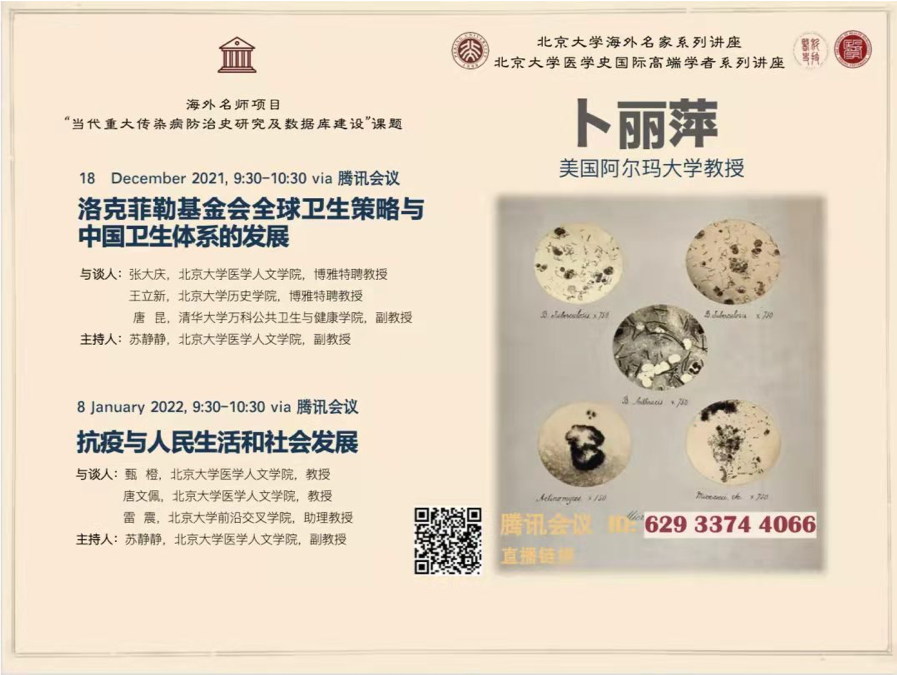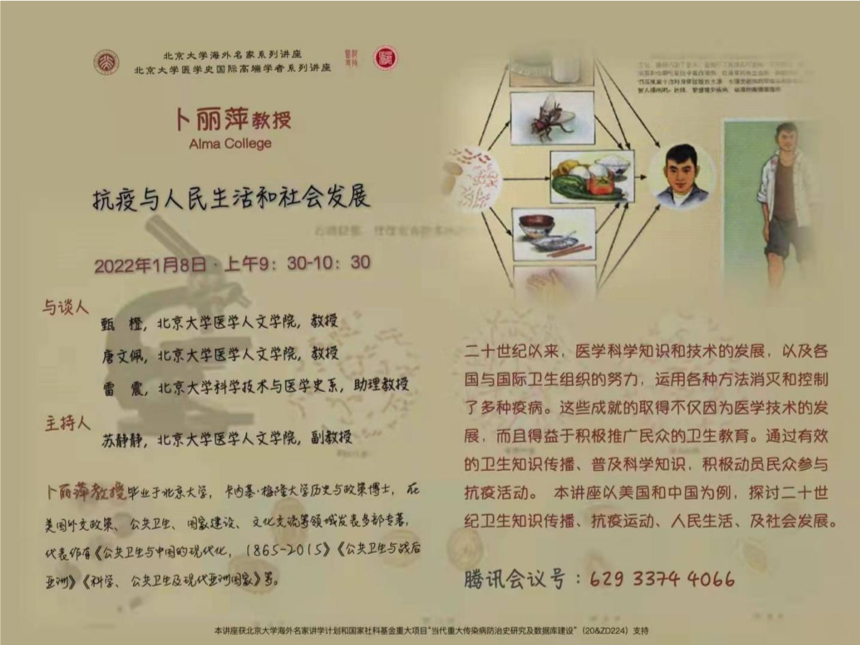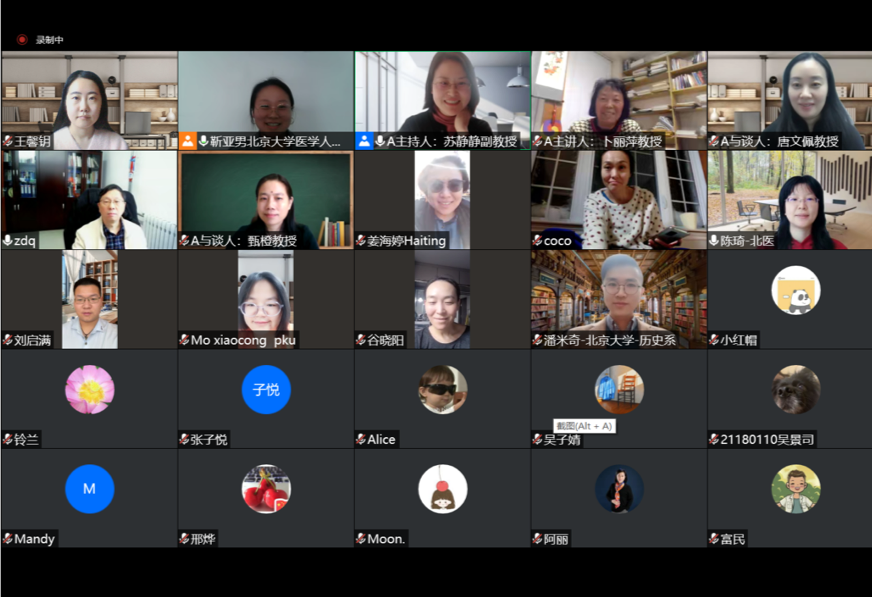Peking University Distinguished Lectureship & Global Health History Lectures: Prof. Bu Liping: Fighting against Epidemics, People’s Life and Social Development
With the support of Peking University Distinguished Lectureship (北京大学海外名家讲学计划) and Chinese National Social Science Foundation Major Project of the “Contemporary Historiography and Database Construction of Epidemics” (0&ZD224), Professor Bu Liping, chair in the history department at Alma College in the United States, was invited to give two online lectures on the hot spots of global health history. The series of lectures were chaired by Associate Professor Su Jingjing (苏静静), from the School of Medical Humanities of Peking University, and organized under the titles of “Rockefeller Foundation’s Global Health Strategy and the Development of China’s Health System” (December 18, 2021), “Fighting against Epidemics, People’s Life and Social Development” (January 8, 2022).


Fighting against Epidemics, People’s Life and Social Development
On January 8, 2022, Professor Bu Liping delivered the second online lecture “Fighting against Epidemics, People’s Life and Social Development”. The lecture took the United States and China as examples and discussed the propagation of hygienic knowledge, the movement of fighting against epidemics, people’s life and social development in the 20thcentury. The lecture was chaired by Su Jingjing (苏静静), associate professor from Peking University School of Medical Humanities. Three experts in this field were invited for the dialogue session, who are Prof. Zhen Cheng (甄橙), from School of Medical Humanities, Peking University; Prof. Tang Wenpei (唐文佩), Professor from School of Medical Humanities, Peking University; John N. Alekna (雷震), assistant professor from Peking University Department of History of Science, Technology and Medicine.
Against the background of COVID-19, throughout the history, it’s not hard to find that the epidemics not only endangered people’s life and health, but also had great impact on economy and society. Since the 20th century, with the development of medical science and technology, as well as the efforts made by governments and international organizations around the world, various of epidemics have been effectively controlled. In this process, the propagation of hygienic knowledge, mass participation in fighting against epidemics have made a crucial contribution. Prof, Bu took the United States and China as examples and presented us with the propaganda and education of hygienic knowledge, the movement of fighting against epidemics, people’s life and social development in the 20th century. The lecture includes five sections, i.e. “Public Health Campaign in the United States”, “rise of health education in China”, “state-run health education in China”, “comparisons: content, method, cultural communication, and social participation” and “technology approach: less emphasis on mass education and social participation”.
1. Public Health Campaign in the United States
The campaign of public health in the United States started at the end of 19th century or early 20th century. It was launched by local governments and non-governmental organizations. The propaganda of public health was taken the lead by full-time public health professionals and officials, who were also in alliance with progressives in society, as well as some influential non-governmental institutions, churches. Many schools and communities in the cities of the United States carried out a variety of public health education and propaganda to popularize hygienic knowledge, which could remind people of paying attention to environmental hygiene, personal hygiene and food hygiene. Characteristic methods like children’s lyrics, fairy tales, clowns, “scouts” etc., and the media for propaganda included songs, Christmas stamps, and posters.
2. Rise of health education in China
The strategies of education campaign in the United States were soon introduced into China. One of the reasons is the establishment of the Young Men’s Christian Association (Y.M.C.A.). It was not only in missionary work, but also emphasized healthy spirit, mind and body. After that, the Y.M.C.A. established Council on Education for Public Health (卫生教育委员会) (chaired by W.W. Peter). In 1913, China also established Chinese Medical Association (中华医学会) (founded by Wu Lien-teh). Both of them have promoted public health campaign in China, with both competition and cooperation, but different purposes. In 1916, these two associations amalgamated into Joint Council on Public Health Education (卫生联合委员会), and in 1920 the organization was renamed Council on Health Education (中华卫生教育会). It has become the most influential non-governmental organization at that time, which focused on public health education and carried out the movement of urban sanitation renovation in large scale, including public health propaganda, such as lectures on maternal and child health.
3. State-run health education in China
In 1928, after the establishment of the Ministry of Health in China, public health education was involved into the organizational system. From 1928 to 1937, the emphasis of work was on urban public health propaganda, including school sanitation, urban cleaning, lectures and exhibitions on public health etc.. From 1950 to 1980, the emphasis was on national health campaign and people’s participation. In this period, the coverage of public health propaganda became universal, and public health education transformed into mass movement. Moreover, epidemic prevention and treatment were closely connected with economy and social change.
4. Comparisons: content, method, cultural communication, and social participation
Taking the prevention and treatment of tuberculosis, malaria as examples, Professor Bu analyzed that from the propaganda materials of public health campaign in China and the United States, we could insight into the social values and people’s life at that time. In the United States, most of the propaganda materials are for the prevention and treatment of a single disease, with warning, humor, cartoon or concise methods. While in China, the propaganda materials are for the prevention and treatment of both single or various diseases, with detailed methods of traditional Chinese art (such as paper cutting, three character classic, couples), and advocating socialist collective power. In addition, posters for epidemic prevention are of great significance to the study of public health campaign. A careful study of the posters is not only helpful to the dissemination of public health information, but also can insight into the social customs, cultural background, code of conduct and values in different countries. For instance, there are obvious differences between the images of women on propaganda posters in Chinese and the United States.
5. Technology approach: less emphasis on mass education and social participation
With the emergence of vaccines and new drugs in the 20th century, a variety of traditional diseases have been effectively controlled. However, people began to pay more attention on the development of science and technology, but neglected other measures, such as health education, and social, economic, cultural factors. Since 1950s in the United States as well as since 1980s in China, people have changed from mass participation to dependency in fighting against epidemics, and have grown more dependent on vaccines. Let’s have some thinking: in the context of widespread COVID-19 pandemic, some people in Western countries are protesting vaccination (though for many reasons). Therefore, many scientists, public health officials have to reflect on the shortcomings of medical science and technology.
During the discussion and Q&A sessions, Prof. Zhen Cheng (甄橙) summarized several changes of health education in China, from learning from foreign countries to independent development, from hygiene education to health education, from health education to health promotion. Prof. Tang Wenpei (唐文佩) agreed that the development of medical science and technology had brought changes to the images of public health propagation, which are making people gradually ignore the education of health. Prof. John N. Alekna (雷震) also noted the difference between China and the United States fighting against epidemics and health education and agreed that humankind have changed from mass participation to technology dependency since the 20th century. The lecture was highly and widely appreciated and received encouraging feedback.

Yang Wenjun, Su Jingjing
School of Health Humanities


